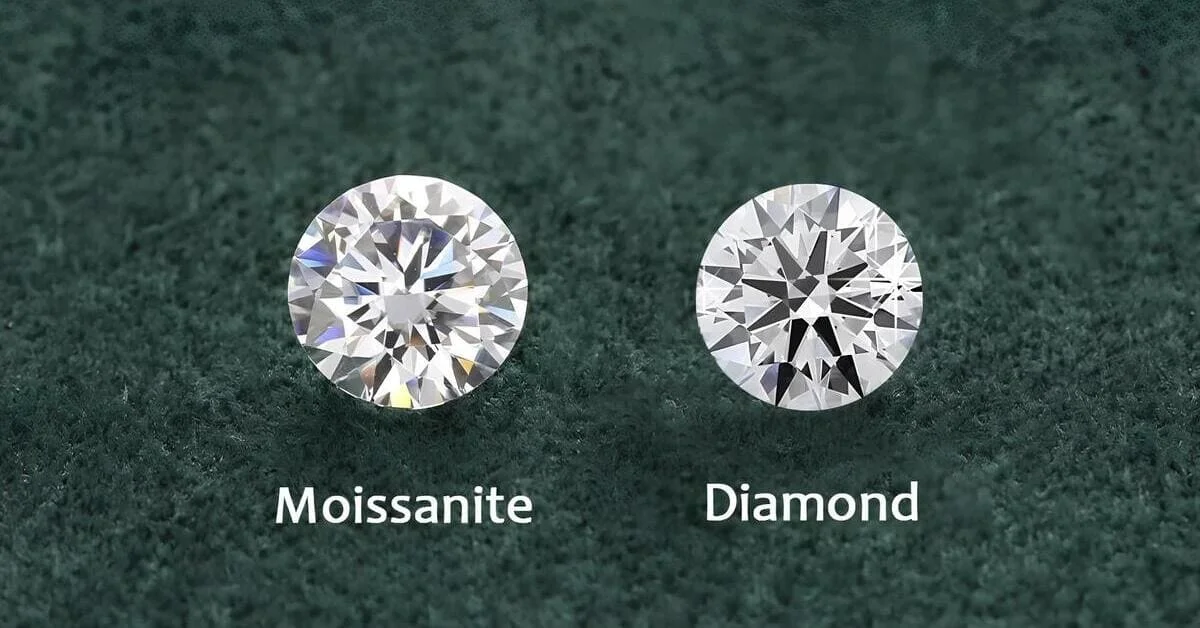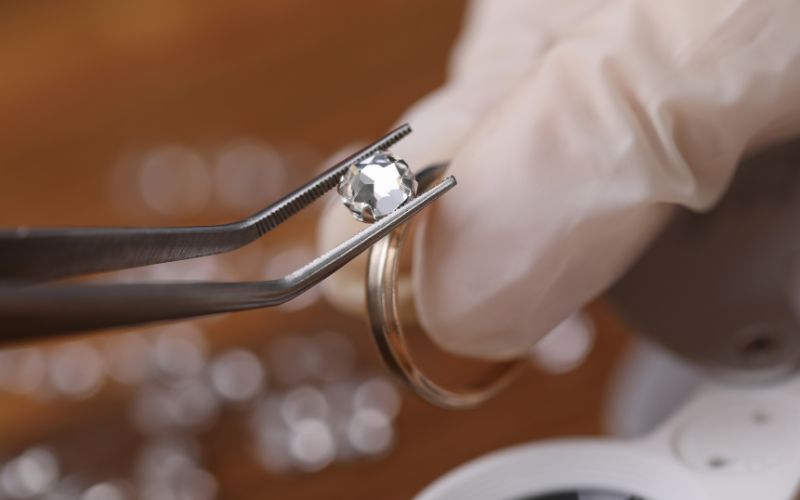If you’re hunting for an engagement ring, then you’ve probably run into a stone that looks like a Diamond, but it’s called a Moissanite. So, what’s that all about?
Well, we’ve been asked this question enough times that we thought it might be useful to give you a round of Moissanite vs. Diamonds so that you can see what each stone brings to the table via similarities and contrasts.
As it turns out, they both have their own perks and pitfalls, so without further ado, let’s take a look at Moissanite vs. Diamonds in a sparkling debate that will give you what you need to make your important decision!
 Pin
PinIn a nutshell, while both stones appear clear and shiny, Moissanite may sometimes have yellows and greens in a bright light, just as Diamonds sometimes have yellows and browns. Moissanite has more Fire and will never lose it due to a lack of ‘cleavage planes’(more on this later), but they sparkle so much brighter than Diamonds that some consider it unnatural.
Both stones are durable, being the hardest and second-hardest materials on the planet, and when it comes to cost you can get a much larger Moissanite for considerably less. We’ll expand on the qualities of both of these beautiful stones in the sections below, but those are some of the chief highlights for those readers out there who are in a bit of a hurry!
The Main Differences Between Moissanite and Diamond
 Pin
PinSometimes contrast is the best way to paint a mental picture of what something is or isn’t, so with that in mind here are the main differences between Moissanite and Diamond:
- Moissanite has a durability/hardness of 9.25 on Mohs Scale, whereas Diamond has a durability/hardness of 10.
- Moissanite has a brilliance on the refractive index of 2.65, whereas Diamond has a brilliance of 2.42.
- Moissanite has a light dispersion/Fire of .104 which disperses as rainbow light, whereas Diamond has a Fire of .044 that disperses as white light.
- Moissanite stones are 15% lighter than Diamonds and sold by the millimeter, whereas Diamonds are sold by their actual weight in carats.
- Moissanite does not have a cleavage plane (an internal plane where the stone may be easily split), whereas Diamonds DO have cleavage planes.
- Colorless Moissanites may be of lightly yellow or green tint in the light (close to K grade on the GIA scale, with one exception we’ll talk about later), whereas Diamond may be colorless or have color which is graded on the GIA scale from D to Z (with colorless Diamonds falling in D-J)
- Rough comparison of price shows that 1 carat of Moissanite might cost $400-$600, whereas a Diamond of the same size, color, and clarity might cost $2000 and up.
What is Moissanite? – An Overview with Key Features
 Pin
PinMoissanite was first discovered in 1893 by a Nobel-prize winning chemist named Dr. Henri Moissan. This particular sample came from space – the good doctor found it while investigating a site in Arizona where meteors had fallen. Chemically, it’s considered ‘Silicon carbide’.
These days, most Moissanites with very few rare exceptions are grown in labs, but despite what you may have heard, they DO occur naturally. Don’t believe us? Well, you can see a record sized piece that was found in Israel at the Gemological Institute of America (GIA) website here
Naturally occurring samples of Moissanite tend to be green or yellow, but lab grown specimens are colorless with some yellow or green being visible in bright light – similar to a K on the GIA color scale for Diamonds.
It definitely has some perks!
While it looks like a Diamond, Moissanite never loses its sparkle. If it’s cloudy, then that just means it’s dirty. This is because Moissanite doesn’t have a ‘cleavage plane’. A cleavage plane is a flat surface inside a Diamond or another natural or lab-created stone where the stone is at its weakest and might theoretically be split in half. Diamonds have these and so as the years go by they can sometimes lose a bit of their luster, despite being the hardest material in the world.
Incidentally, Moissanite is the SECOND hardest material in the world. These stones register at 9.25 on Mohs Scale of hardness, with Diamonds scoring a perfect 10, so Moissanite stones can last a lifetime.
Moissanite is also a lightweight stone, weighing 15% less than a Diamond of the same size, and it’s light enough that it’s sold in millimeters.
This brings us to our final perk – the price! For a 1 carat Moissanite, you might pay $400-$600, while a Diamond of the same size would set you back $2000 to as much as $20,000.
So, to sum it up, a Moissanite stone that you see in a store is lab-grown, harder than anything BUT Diamond, and it never loses its Fire. Oh, and if you’re worried about the yellow or green tint that can show in bright light, ‘Forever Brilliant’ Moissanites are available in true colorless with a nearly flawless clarity. If you’re curious, you can see some really amazing examples of Moissanite engagement jewelry at Flawless Moissanite!
 Pin
PinPros/Cons of Moissanite
 Pin
PinAs a final means of providing definition to what Moissanite is or isn’t, it’s time to break it down into the pros and cons of these beautiful stones. We’ll start with the Pros and go from there.
The Pros:
- Moissanite never loses its sparkle and with a higher refractive index score than Diamonds, they REALLY sparkle – It reflects light more than any other stone in the world!
- As modern Moissanite is lab-created, the clarity is almost always superior – it’s extremely rare to find Moissanite with any sort of blemish or visible inclusions.
- Moissanites cost considerably less than Diamonds, so it is easier to afford a larger, perfect stone, and this is a big advantage if you are on a very tight budget.
- While they do occur in nature, as most modern Moissanite is lab-created there are no ethical considerations for the environment or the sourcing of the stone that might come into play for some buyers.
- Moissanites are durable – the only thing on the planet that can scratch a Moissanite is a Diamond.
- Moissanite can be cut into any shape.
The Cons:
- While Diamonds retain some of their value when resold, Moissanites are not considered to be a valuable commodity from a resale perspective.
- The sparkle from Moissanite is quite intense – more so than you would see with a Diamond – and while this is incredibly appealing to some, other potential buyers feel that it looks a bit unnatural.
- While they DO rarely occur in nature (from meteors and from the sites that we linked earlier), as most Moissanite is fabricated, there is some stigma to them for being most commonly artificial.
What are Diamonds? An Overview with Key Features
 Pin
PinDiamonds, as we all know, are made of carbon which is compressed deep within the Earth, and it’s kind of interesting that the stone associated with marriage is so closely associated with us – we’re carbon-based lifeforms, after all!
These precious stones are prized for being clear and colorless and when you think of a Diamond you think of its durability (it’s the hardest material on Earth), its clarity, and it’s amazing sparkle. The way that these stones are rating actually breaks down into 4 categories:
- Cut – Simply put, the shape in which the Diamond is cut decides how it will interact with light.
- Carat – The weight of the Diamond itself (the root of ‘carat’ being derived from the Carob seed.)
- Clarity – Natural Diamonds will have blemishes and inclusions when they form, and clarity is a measure of their impact to the overall appearance of the stone.
- Color – Many Diamonds look completely clear until you get a closer look, at which point you’ll notice shades of yellow or brown. Diamonds are rated on a scale of D (colorless) to Z (heavy tins or brown or yellow)
As it’s the hardest substance on Earth, we definitely grow Diamonds in labs as well as mine them from the Earth, with the mined variety naturally being rarer and more sought after.
As far as their perks, it’s all about the sparkle and the longevity – Diamonds catch light in a way uniquely their own and their durability as the toughest mineral on the planet means that they can be passed down for many lifetimes. They CAN lose some of their sparkle, due to the natural formation of cleavage planes inside, but it is uncommon and when it does happen, it’s generally the product of a substantial amount of years and ill-treatment of the stone.
All of that perfection comes at a price, however, so while Diamonds are certainly accessible to everyone, the ones with finer clarity and color will cost considerably more.
Pros/Cons of Diamonds
 Pin
PinTo further define these famous stones, a bit of contrast in the form of pros and cons is called form, so that you’ll have a better idea of what a Diamond brings to the table. Let’s take a look!
The Pros:
- Diamonds are famously neutral in color and this lets you easily pair them with any other gemstones.
- They have a very distinctive sparkle that’s like no other stone.
- Diamonds are indeed forever – as the hardest material on the planet, they will stand the tests of time.
- Diamonds can be cut into any shape.
The Cons:
- As Diamonds are popular, they are much less unique than other gemstones – you can see them anywhere you go.
- Some may have ethical considerations about how or where they were mined.
- Diamonds are more cost-prohibitive – while you can certainly save money purchasing a lab grown Diamond, these are considered to be worth less than natural Diamonds.
- Diamonds have natural blemishes and inclusions. An experienced Jeweler can do a lot to hide this, but finding a stone with very few blemishes can add substantially to cost.
Other Alternatives to Consider
If you’re still not sure what stone you would like to go with, then don’t worry – you’ve always got alternatives. Below you’ll find a few to consider in order to help you make your final decision.
Lab-Grown Diamonds
Lab grown Diamonds are definitely an option and one with considerable savings, generally to the tune of 60% to 85% less than what you’d spend on a natural Diamond of the same clarity and carat. Keep in mind that this reduces the resale value, although we should probably mention that even natural Diamonds don’t have a lot of heft where resale is concerned (they’re certainly valuable, but while you could invest in gold ingots and make a profit if you waited, that doesn’t really happen with Diamonds).
Colored gemstones
While the first Diamond engagement ring we’ve confirmed in history dates as far back as 1477 (it was commissioned in Austria by Archduke Maximillian for Mary of Burgundy), diamond engagement rings really took off briefly during the Victorian era (although they also favored sapphires!) and then in force in 1947, after De Beers coined the phrase ‘A Diamond is Forever’. They would then launch an epic advertising campaign that was so successful, the world now thinks ‘diamonds’ when it comes to engagement rings.
Well… sort of.
You see, it really depends on the culture. If you were proposing to a woman in France, you might be labeled ‘boring’ for proposing with a Diamond, as more colorful stones like Emeralds and Rubies were considered to be rarer and more beautiful.
In Finland and Denmark, it was traditional to skip the stone and go with a pure band of gold and in India, rings were skipped altogether in favor of lovely engagement bangles worn on the wrist or the Hindu tradition of a Bichaya – a ring worn on the toe.
I think you get where we’re going here!
Colored gemstones are a fantastic way to create something unique and too often this gets overlooked. If you walked out on a city street and tossed a water balloon into a crowd, you’d probably hit at least 2 – 3 people wearing diamonds.
So keep colored gemstones in mind, especially birthstones, and stones in colors that your beloved adores. You never know – you might decide to skip the Diamonds or simply use them as smaller ‘backup players’ for a beautiful natural gemstone you’ve chosen with thought and care for someone you love!
FAQs
We’ve just about run out of time for today, but before we formally close things out, we’ve got a few frequently asked questions about Moissanite and Diamonds that we thought you might find useful. Let’s take a look!
Is Moissanite a fake Diamond?
No, Moissanite is not a fake diamond, it’s silicon carbonate and we’ve found it on Meteors, in digs along the Kishon river in Israel, and in the mountains of Czechoslovakia. So, no, it’s not a fake Diamond. While it certainly looks like a Diamond, it is both a naturally occurring and lab grown stone all its own.
Is Moissanite worth buying?
Yes, Moissanite is certainly worth buying. It has the most brilliance of any stone in the world and more than that, it NEVER loses it. While it’s second in hardness to Diamonds, structurally it will not degrade in the same way. Diamonds can sometimes lose a little brilliance due to the weakness of cleavage planes that occur naturally within the stones, but Moissanite doesn’t have these. It would be safe to say, ‘Diamonds are forever, but Moissanite will always shine the same’.
Which Moissanite cut makes it look the most like a Diamond?
Any cut, really, but if we had to pick one, a round-cut Moissanite is probably going to be the closest in appearance. If you are worried that the sparkle will give it away with other cuts, then don’t — it’s not overpowering. We highly recommend comparing a Diamond and a Moissanite sparkle in person sometime. You can see that the Moissanite is much more brilliant but not to the point that someone will cry ‘fake!’.
In Conclusion
Today we’ve pitted Moissanite vs. Diamond in order to give you a better picture of the qualities and contrasts for each stone. As you can see, they certainly both have perks. While Diamond is the hardest stone on the planet, Moissanite is the second-hardest and it refracts more light than Diamonds due to a higher refractive index.
Both stones occur in nature and in labs and a big difference is that over time a Diamond’s sparkle might actually dull a little, but a Moissanite’s brilliance never fades. Finally, Moissanite is certainly more cost-effective, as it is sold by the millimeter rather than the carat, so we hope this helps to clear things up a bit as far as what makes these stones different and what they have in common.
Now that you know all about both of these stones, which one will you choose? Either way, nothing sparkles quite like a Moissanite or a Diamond – they truly have qualities uniquely their own!
If you want to see more beautiful types of Moissanite rings, have a look at this list of pear shaped Moissanite rings.













Leave a Reply